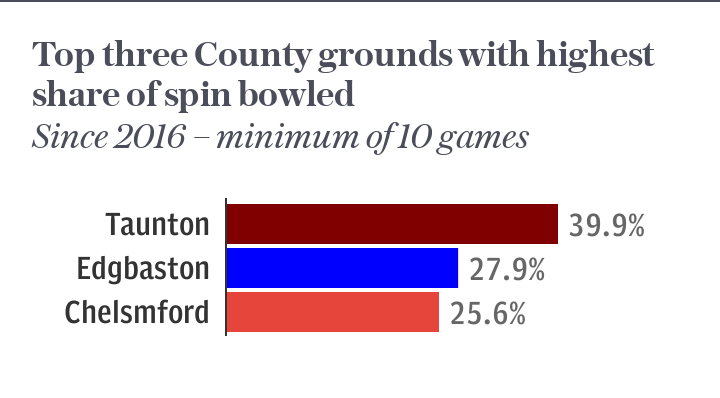Somerset-bred spinners Dom Bess and Jack Leach show value of honing skills on Taunton's turner

England’s victory in the opening Test in Sri Lanka was forged 9,000 kilometres away, at Taunton. For it was in the shadow of the Quantocks that Dom Bess and Jack Leach were given the most precious gift for an aspiring English spin bowler: enough overs to bowl.
It is no coincidence that Bess and Leach, who shared 14 wickets in Galle, are both products of Somerset. No home ground has been anything like as conducive to spin in recent years as Taunton. Since 2016, 40 per cent of overs at the ground have been by spinners, comfortably the highest of any regular county ground. While other counties have often had no need to select a specialist spinner, Somerset have normally needed two at home.

“Playing on those wickets gives you a lot more overs and lets you sort of learn the art of bowling spin and having that experience of people looking at you to bowl teams out,” Jack Leach told Telegraph Sport before taking his Test tally in Sri Lanka to 24 wickets in four Tests. “There were probably still times where I didn't do it and it's as much about those experiences as it is about the ones where you managed to do it. I think you learn a lot from mistakes you make.”
Spinners from other counties are too seldom allowed to make these mistakes. No Test nation in the world bowls as little spin as England’s 22 per cent in first-class cricket since the start of 2015. So, whatever their talents, most English spinners are simply stunted by not being able to bowl enough.
The former England spinner Gareth Batty recently lamented that, in county cricket, “lots of spinners are used to keep the over-rate up, or you're just going to come on for a few overs in the second innings to rotate the seamers.” For Bess and Leach, the experience at Taunton has been more akin to how spinners are ordinarily used in the subcontinent: to control the game, and learn the art of bowling long spells.
“The key to developing spinners in the UK is creating opportunities for them to bowl overs – and that can be challenging,” says Andy Hurry, Somerset’s director of cricket. “They need the opportunity to set batters up. They have to understand how to work batters out and work towards a plan.”
The success that Bess and Leach enjoyed in Galle was the first time that two England spinners reared in the same county had played together in a Test since 2012, when Northamptonshire-raised pair Monty Panesar and Graeme Swann shared a brilliant alliance in India.

When Panesar and Swann were breaking through at Northants – they played together from Panesar’s first-class debut in 2001 until the end of 2004, when Swann left for Nottinghamshire – the club’s home ground, Wantage Road, was frequently lambasted for offering excessive turn. In 2003, after several warnings, the county were handed an eight-point penalty by pitch inspectors for a “poor” pitch in a game against Worcestershire.
Such unwelcome attention from the pitch inspectors has been familiar to Somerset in recent years. After years of criticism of the turn offered at ‘Ciderabad’, Somerset were handed a 12-point penalty for their pitch against Essex in 2019 because of “excessive unevenness of bounce”.
“Swanny and Monty had a very similar pitch to bowl on at Northampton – you’re bowling more overs and also you’re getting more encouragement,” recalls Carl Crowe, a former Leicestershire off spinner who is now a spin coach for Lancashire.
He believes that such wickets can accelerate spinners’ development. “If you’re bowling on a spinning wicket and you release a ball that should spin and it does spin – you’re getting immediate feedback, the dopamine hit from seeing the ball spin. If you’re bowling on a wicket that doesn’t spin, which is most the wickets in England, no matter how many revs you impart on the ball behaves the same. So that feedback from your action is not there.”
For all the controversy about the turn at Taunton, spinners still bowl a markedly lower share of overs there than in Tests in any Asian Test nation in the last five years. Indeed, over 60 per cent of overs bowled in Tests in both India and Sri Lanka since 2016 have been by spinners. And so while the turn and bite offered at Taunton has been exceptional by English standards, it has been nothing unusual by the standards of what England face when they venture abroad.
There are “double standards” in how pitch inspectors treat wickets that offer assistance for seam and spin, Batty believes, with turning tracks treated far more harshly – even though they are far more common in the international game than green seamers.

Somerset have already moved to change the character of Taunton to make it less spin friendly. That will make further sanctions less likely, but it will also make the character of pitches in the county game more monochrome, continuing a trend that Batty has observed in a 24-year county career.
With an 18-team first-class structure, one of England’s competitive advantages should be an array of different pitches which – even allowing for England’s climate – can go some way to replicating the diversity of conditions around the world. Wickets that offer extreme turn by English standards are an education for spinners about what is required when they go to Asia – and batsmen about how to play the turning ball.
Perhaps this is the lesson from Galle 2021 and Mumbai 2012. The same county wickets that pitch inspectors have reprimanded may help the England team.

 Yahoo Sport
Yahoo Sport 





































